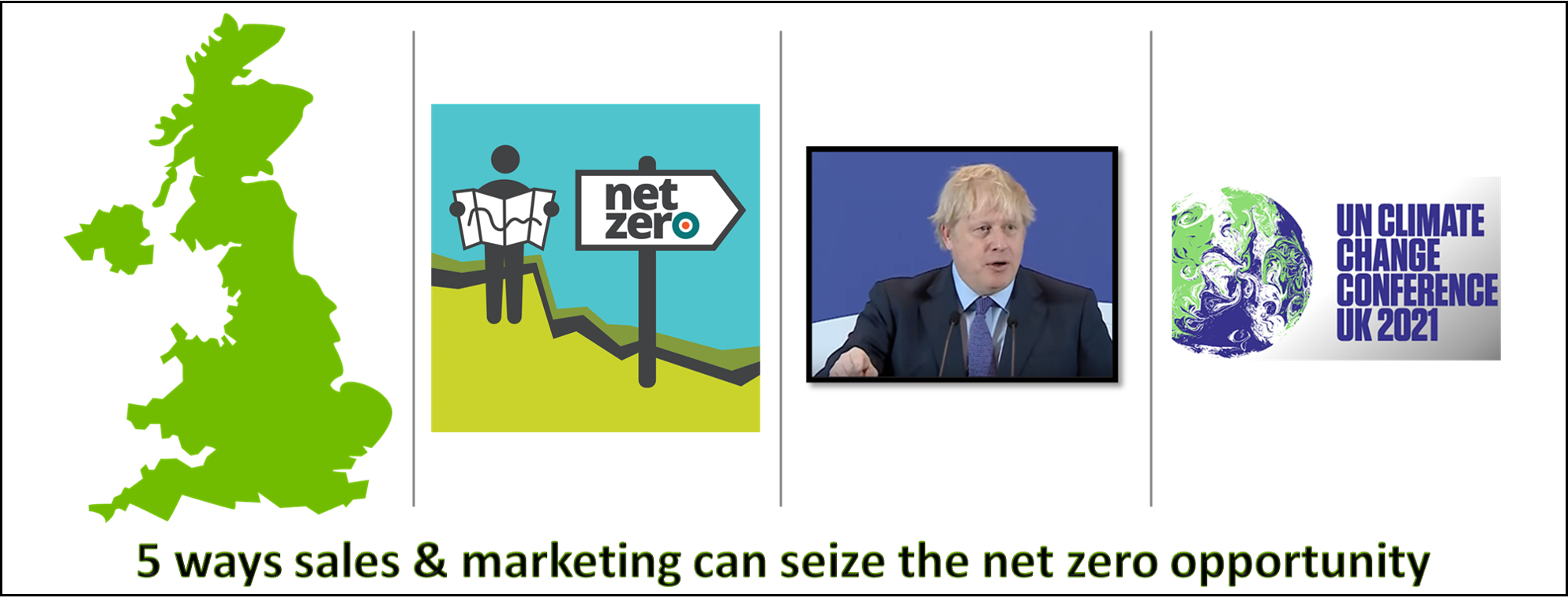
5 ways to seize the net zero opportunity in a Green Industrial Revolution
The UK Government has laid out their strategy to enable the UK to achieve its net zero goals and create the conditions for a Green Industrial Revolution. The strategy whitepaper is called Build Back Greener.
This article offers sales and marketing leaders 5 tips for action they can take today. These actions will help to make the most of the new net zero opportunity created by these policies in the new net zero economy.
What was announced?
In his clearest statement yet on commitment to the Green economy, Boris Johnson set out the government’s serious intent for a “green industrial revolution” in the UK. The policy aim is to create 250,000 jobs, to level up the UK economy and to allow the UK to eradicate its “contribution to climate change by 2050”. Detail on these wide ranging commitments can be found below.[1]
This policy will hasten significant changes that will impact all of us. Although many of these targets seem to be some time in the future, these announcements of major investments and specific priorities, provide clear direction to business and society as to the direction of travel.
So, the question for leaders in all sectors of the economy is: what action needs to be taken now to prepare for and make the most of the opportunities ahead?
5 ways sales & marketing can seize the net zero opportunity
In this article we focus on how Sales and Marketing leaders can respond to this announcement. We offer these 5 ideas for action that can be taken now and the benefits they can bring.
1. Survey your existing client’s attitude, challenges and intent on net zero.
Leverage your existing relationships and contacts to get a better understanding of clients’ needs and how and where you can best support them. Some will be early adopters of net zero. They are already taking steps to prioritise on suppliers with low carbon credentials and are adopting new ways of working to reduce their own emissions. This can provide a guide to where other customers and potentially prospects will follow. How can you help them? What needs can you anticipate and be ready for?
2. Understand your organisation’s own Carbon footprint. Recognise its strengths and weaknesses and consider how this might be perceived by your customers
More organisations are asking more probing questions about their suppliers’ management of their carbon footprint. In the past, you may have avoided scrutiny with a few ‘artfully vague’ responses. This is changing and your customers will want real answers and proof of commitment. Remember your carbon footprint is part of their supply chain impact. Far better to be proactive, demonstrate leadership and reduce the risk of being excluded from a tender because you were not fully aware of how your organisation stacks up versus competitors.
3. Enable your client facing staff with a clear set of messages about your carbon credentials and your own plans for carbon reduction
As part of a proactive approach, making your own net zero journey a priority in the business will have benefits in the way your brand is perceived by your customers. By raising the sense of importance of carbon reduction and being clear on your messaging sends strong signals of your commitment. Your customers that are early adopters of net zero already have their radar on for this and you may already be losing out. Equipping your people with this knowledge means that you also enable them to understand your client’s net zero ambitions. This enables them to be more effective in aligning your business with these client aspirations and potentially identifying new business opportunities earlier.
4. Identify where your products and services help your customers net zero journey and build this into your value proposition
Building on what you have learnt from client surveys (see Idea 1) or feedback, there may be attributes and features of your offerings that provide areas of value to your customer that till now, have been overlooked. Applying a carbon impact lens to your offerings can be valuable in identifying new propositions or market needs that can drive new growth opportunities. Our experience indicates that there are many sources of unclaimed value that can improve margins or generate new sources of profitable revenues.
5. Take time out to consider how the net zero transition is likely to change your marketplace.
Sounds obvious, but in the midst of the Covid challenges, quarterly targets and the likes this is easily missed. Taking time out to understand the long term changes and the near term implications is essential to proactively managing the impact of net zero on your business. Early action offers the chance to identify and engage new decision makers in your customers or to build relationship with key influencers or recruit new partners in your markets. For some, it will help to recognise new market opportunities, while for others it may mitigate the risks as their markets evolve in response to this driver.
These 5 ideas are just some starting points.
The net zero transition is set to last for decades and will impact almost every part of the economy. For those that take early action to understand the impact of net zero on their markets will be better prepared to survive and thrive than those that ignore them.
How can you seize your net zero opportunity?

You can find answers to this question here.






